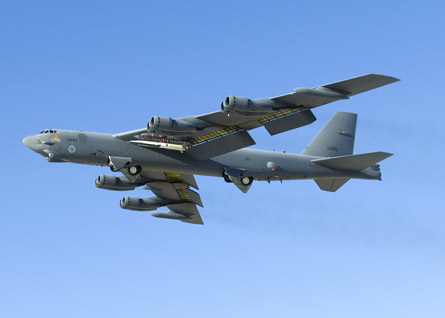US Air Force and Boeing researchers on 26 May took a leap towards harnessing hypersonic vehicles for space access or weapons applications with the longest-ever supersonic combustion ramjet-powered flight, off the southern California Pacific coast.
The Boeing Phantom Works-built X-51A Waverider achieved 140s burn of its Pratt & Whitney Rocketdyne-built air breathing scramjet engine and accelerated to 70,000ft (21,350m) and Mach 5 before controllers at the Point Mugu naval air warfare centre sea range terminated the mission because of a loss of telemetry.
The previous longest scramjet burn in a flight test was 12s in a hydrogen-based engine in the NASA X-43.
The X-51A was carried to about 49,500ft under the wing of a Boeing B-52H before release. Four seconds later an Army Tactical Missile solid rocket booster accelerated the X-51 to about M4.8 before it and a connecting interstage were jettisoned.
 |
|---|
© U.S. Air Force photo/Mike CassidyAn X-51A Waverider successfully launched from a B-52 Stratofortress |
Air Force Research Laboratory X-51A programme manager Charlie Brink says preliminary data shows that the separation from the B-52H was "phenomenal" and the solid booster light was "perfect". At 65,000ft the booster separated from the vehicle as planned, followed by the start of the scramjet engine with an ethylene mix and switchover to JP-7 fuel.
While the programme had a goal for a 300s flight to M6, Brink says that at roughly 140s of powered flight, engineers "started noticing some anomalies with some sensors". The engine continued to run, but the telemetry stream to the ground was interrupted, requiring controllers to activate the self-destruct function.
Despite the shorter flight, the team was exhilarated over the results. "Up until 140s, everything was working textbook, per calculations", says Joe Vogel, Boeing's X-51A programme manager.
In M5-plus hypersonic flight, heat and pressure make conventional turbine engines impractical. A scramjet's great advantage is the ability to capture and burn oxygen in thin atmosphere, rather than having to carry it in a large tank like other rockets. Not having to carry the oxidizer needed for combustion means more payload capability.
Brink says engineers will review data for the rest of the fiscal year and the programme is likely to pick up with flight tests in October or November, incorporating any required lessons learned from the 26 May flight.
The X-51A was released from under the B-52's wing at 49,500ft
Source: Flight International




















